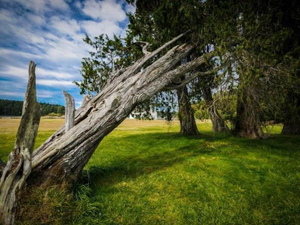| Error processing SSI file |
||
| Error processing SSI file |
||
| Error processing SSI file |
||
Error processing SSI file |
About Marine Protected Areas
San Juan Island National Historic Park
Landscape found at a San Juan Island National Historic Park In the San Juan Islands in Washington, the US and Canada nearly went to war over a pig. But let's start at the beginning. Long before the arrival of Europeans, the San Juan Island was home to the Coast Salish tribes, attracted by its temperate climate, rich soil, abundant timber and marine resources. These same attributes lured explorers from Spain, Great Britain and the United States. Each explored, charted and named the islands while staking overlapping claims to the region. By the early 1800s, Spain had abandoned its claim, and tensions between the U.S. and Britain were rising. Americans considered the British presence an affront to their "manifest destiny" to occupy North America. The British believed they had a legal right to lands guaranteed by earlier treaties, explorations and commercial activities. In June 1846 the Treaty of Oregon was signed, setting the boundary on the 49th parallel, from the Rocky Mountains "to the middle of the channel which separates the continent from Vancouver's Island" then south through the channel to the Strait of Juan de Fuca and west to the Pacific Ocean. However, the "channel" described in the treaty was actually two channels: the Haro Strait, nearest Vancouver Island, and the Rosario Strait, nearer the mainland. The San Juan Islands lay between, and both sides claimed the entire island group. The crisis came on June 15, 1859, when Lyman Cutlar, an American, shot and killed a pig rooting in his garden. When British authorities threatened to arrest Cutlar and evict all his countrymen from the island as trespassers, a delegation sought military protection. Both sides sent small armies to the site for reinforcement. On October 21, 1872, after many years of disputes and squabbles, a three-man arbitration commission ruled in favor of the United States, establishing the boundary line through Haro Strait. Thus the San Juan Islands became American possessions and the final boundary between Canada and the United States was set. Today, the San Juan Islands National Historic Park celebrates this history and protects the areas diverse coastal wildlife. Did you know?
Learn more/get involved:
|
|
